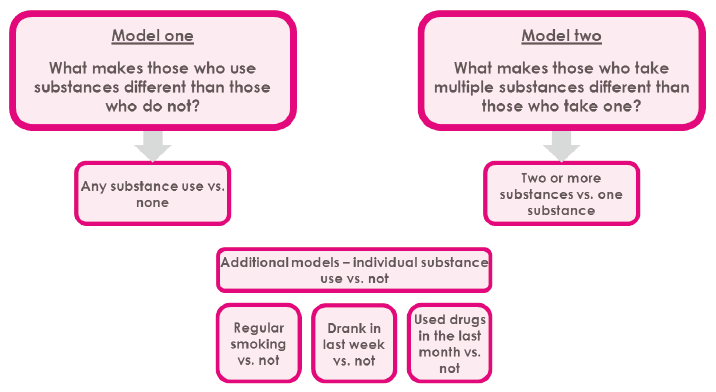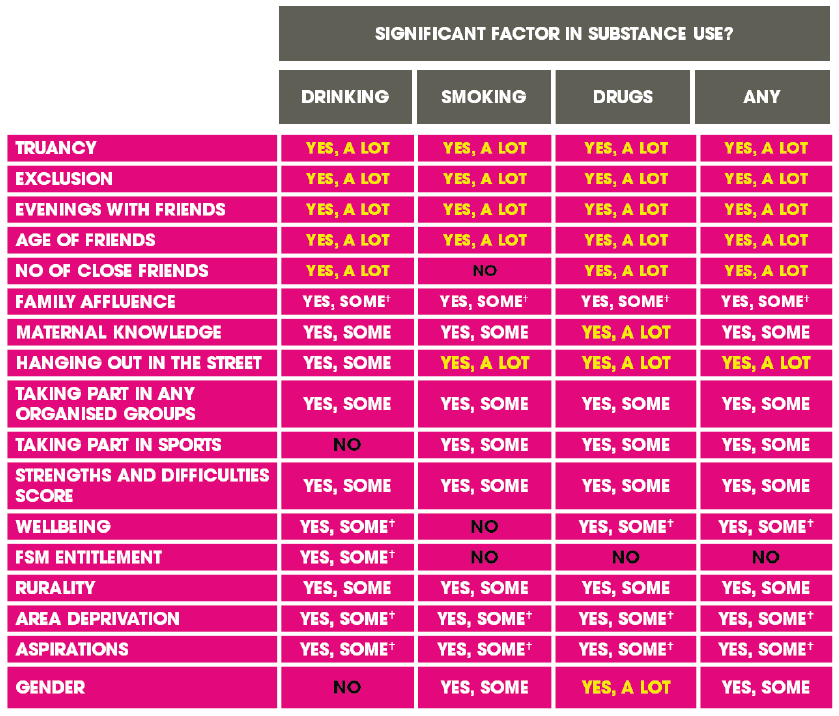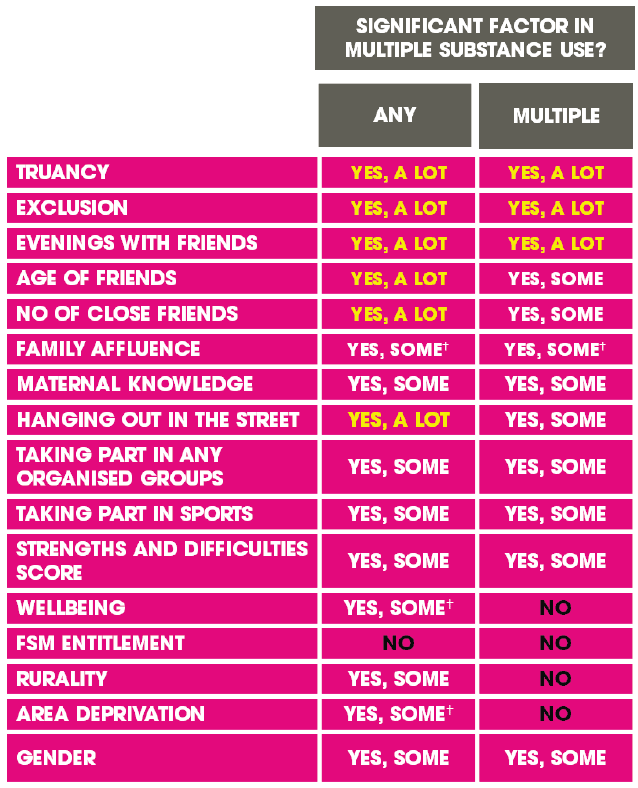Multiple Substance Use Among Adolescents in Scotland: Profile and Trends
This report examines the prevalence of regular use of 2 or more substances among adolescents in Scotland, and key factors associated with multiple substance use.
This document is part of a collection
4 Predictors of multiple substance use
Key findings
- The factors that were the strongest drivers of any substance use were exclusion from school, truanting, number of evenings spent with friends, and age of friends.
- The factors which drove any substance use (see above) were the same ones that differentiated between multiple and single substances use.
4.1 Logistic regression is used to predict an outcome using several predictor variables. In this report, logistic regression was used to predict substance use and multiple substance use. The data used was limited to 15 year olds in 2010 and 2013[18].
4.2 The main benefit of using logistic regression in this context is to clearly distinguish the different effects of the various factors. By including in the logistic regression models, for example, the Scottish Index of Multiple Deprivation (SIMD) and perceptions of family affluence, it is possible to separate the effect of each of these. This means that any significant difference by any factor is independent of any other factors (i.e. whether area deprivation is a significant factor that is separate from family affluence).
Figure 4.1 - Logistic regression models undertaken

4.3 Two main logistic regression models were run: any substance use versus no substance use (we also examined the drivers of drinking, smoking and drug use separately) and use of two or more substances versus use of one substance (Figure 4.1).
4.4 The potential factors included in each of the logistic regressions were those analysed across the six themes covered earlier in this report: geography and deprivation, family, friends, mental health, school and leisure activities. We used this inclusive approach so that we had the same explanatory variables in each of the models that were run, thus allowing comparability across the models. The factors included are detailed in Table 4.1.
Table 4.1 - Factors included in each logistic regression

What the models show
Model 1 - What makes those who use tobacco, alcohol and drugs different from those who do not?
4.5 Overall, a large number of different factors were associated with a greater likelihood of using any substances (being male, an abnormal Strength and Difficulties score, having no close friends, taking part in unsupervised social activities, low maternal and paternal knowledge etc.). This confirmed much of the analysis that precedes this section and suggested that there is no single driver of substance use.
4.6 Figure 4.2[19] highlights the key drivers of substance use. The detailed regression results can be found in Table C.1 (Appendix C). The drivers of drinking, smoking and taking drugs individually are also summarised in Figure 4.2, with detailed results in Table C.2 in the appendices.
Figure 4.2 Summary of key drivers of individual and any substance use among 15 year olds in 2013

4.7 Exclusion from school, frequent truanting, and a greater number of evenings out with friends were the three factors that had the largest impact on likelihood to use at least one substance, with all increasing the likelihood of substance use considerably.
4.8 The factors that had the strongest impact on any substance use[20] (ever excluded from school, level of truancy, number of evenings spent with friends, and whether friends are older) were all significantly correlated with drinking, smoking and taking drugs individually.
Substance Use and Deprivation
The findings in chapter three showed that multiple substance use is higher among pupils living in areas of deprivation.
However, the regression model suggested that once all other factors are controlled for, those in the most deprived quintile are slightly, but significantly, less likely to use at least one substance.
Whether a pupil lived in a deprived or non-deprived area also made no difference to the number of substances that they used, once all other factors were controlled for.
As discussed in section 3.6, SIMD is an area based measure of deprivation rather than an individual one, so it is perhaps no surprise that personal factors related to the pupil as an individual and their family (e.g. engagement with school, friends, parental monitoring) were stronger in the model.
Model 2 - What makes those who use two or more substances different to those who use one?
4.9 The factors that had the strongest impact in the first model also had the strongest impact in the second model. Figure 4.3 highlights the factors that had the biggest impact on multiple substance use (detailed regression results can be found in Table C3 - Appendix C). Exclusion from school, higher levels of truanting, and a higher number of evenings spent with friends were strongly correlated with multiple substance use over single substance use.
4.10 Being male, low maternal knowledge of activities, not taking part in an organised activity, not taking part in a sport, frequently hanging around the streets, and having older friends were also significant in distinguishing between multiple and single substance use.
4.11 All these factors were also significant in the first model. This suggests that differences in the drivers of substance use and multiple substance use are more a matter of degree rather than of kind.
Figure 4.3 - Summary of key drivers of multiple substance use among 15 year olds in 2013

Contact
Email: Emma McCallum
There is a problem
Thanks for your feedback